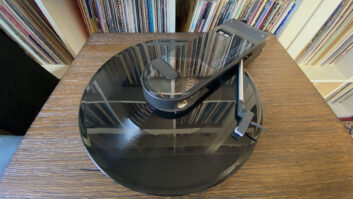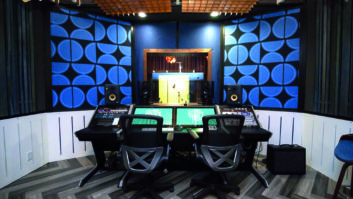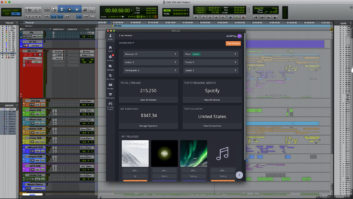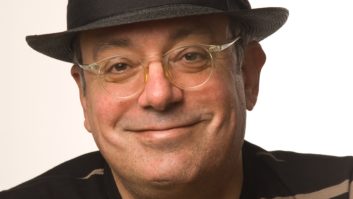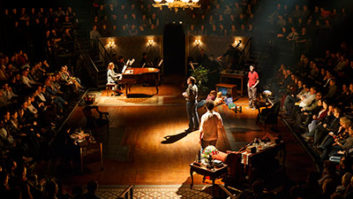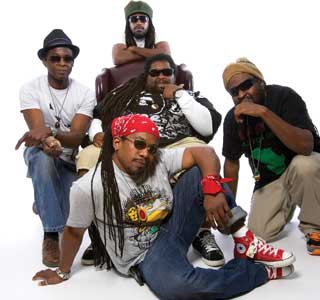
Clockwise from front: Lancelot Hall, Touter Harvey, Junior Jazz, Ian Lewis and Roger Lewis (in chair)
Photo: Peter Langone
There are worse fates than being heavily associated with a single song. In the case of long-running reggae band Inner Circle, they will forever be linked in the public mind with the catchy song “Bad Boys,” which became the theme song for the reality series Cops beginning in 1989. But that only scratches the surface of this group.
In fact, some of the members of Inner Circle have been playing together since they were teenagers in Jamaica, backing up rising star Bob Marley at one point and then establishing themselves as one of the most popular acts on the island during the late ’70s when they were led by the great Rastafarian singer Jacob Miller. Miller’s death in a car accident in 1980 derailed the band for a while, and founding members Roger Lewis and Ian Lewis (guitar and bass, respectively) and longtime keyboardist Touter Harvey relocated to Miami, where they opened Circle House Studios.
They re-formed in earnest in the mid-’80s with a new singer, Calton Coffie, and adapted a slightly more commercial sound that incorporated more from R&B and pop elements (actually, part of their roots) than their grittier previous sound. “Bad Boys” originally came out in 1987, but it was when Cops really took off in the early ’90s and became an unexpected worldwide phenomenon that Inner Circle hit its peak. The song topped the charts in Sweden, of all places, did well throughout Europe and reached the Top 10 in the U.S. in 1993; other lesser hits followed in the late ’90s. Since then, there have been a couple of other singers, but through it all, the Lewises and Harvey have kept Inner Circle strong while their Circle House compound has grown to encompass three SSL rooms and the band’s own separate Digidesign ICON-equipped studio/rehearsal space, and has become world-renowned in the process.
The group’s new album, State of Da World, is their first studio effort in a while, and it nicely showcases the current lineup of the group — the Lewises, Harvey, drummer Lancelot Hall (a 20-year Inner Circle vet) and singer/guitarist Junior Jazz (a 10-year member) — augmented by an impressive array of guests plucked from different strains of reggae, including Damian Marley and Stephen Marley, Mutubaruka, Morgan Heritage, Steel Pulse’s David Hinds and the eclectic duo Slightly Stoopid. The album spans a wide range of styles, from glossy, electronic keyboard-dominated pop reggae (even using in-vogue electronically pitched vocals here and there) to tougher and deeper more “traditional” sounds, and even a couple of creamy R&B-inflected ballads. As one might expect from the album title, there is a social consciousness coursing through many of the songs: Inner Circle, like so many reggae bands, envisions a world where there is freedom from oppression and justice prevails; where love reigns supreme — and ganja is legal. There are two songs dealing with that theme on the album, including a re-make of their own “Mary Mary” (with Slightly Stoopid). I’m just a few minutes into a conversation with Roger Lewis when he brings that topic up.
“They puttin’ all these people in jail — for what, mon? For smokin’ God’s good herb? It not right,” he says in his thick Jamaican patois from the group’s headquarters at Circle House Studios. “Weed should be decriminalized and put right alongside alcohol, because we firmly believe that if you can drink alcohol, weed supposed to be legal, too. So we sing about that, too.”
Roger Lewis bristles somewhat at a question about the group’s commercial inclinations — clearly, he’s heard this line of questioning before: “Some people say we’re too happy for them. They call us a ‘glad-pop’ band. They love bands like Burning Spear because they hard-core spiritual. But people don’t understand the versatility of us. Listen closely to this album, mon. There’s a lot there beneath the surface. When we made this, we said, ‘Let’s give them truly what’s in our hearts, our wealth of experience, some social commentary.’”
The album was two-plus years in the making; not surprisingly, it was tracked at Circle House in the group’s own space. Roger Lewis notes that it started out purely as a group effort: “None [of the songs] were done with the guests in mind originally. The thing about creation is you don’t know where something is going. You start with a riddim, you start with an idea, you start with a feel, let it evolve. You come up with something, work wit’ it, and than maybe later you say, ‘Damn, that would sound more wicked wit’ dis guy on there or wit’ dis kind of sound.’ But we started trying to record the tracks live, as a band, like old-time Jamaica.”
What was a typical session like? “Gather around midday or one o’clock every day,” Roger Lewis replies, “then go to one or two in the morning, depending on the vibe. Jammin’, workin’ songs out. In between there’s a lot of food eatin’ and the domino playin’ and arguing.’” [Laughs] The group doesn’t have to worry about the expense of studio time, or hiring an outside engineer, either — bassist Ian Lewis has been covering that end of things for the band for some time.
Asked who his mentors were in learning engineering, Ian Lewis credits Jack Nuber, who cut some of Bob Marley’s later albums and worked with Talking Heads, Robert Palmer and others down at Compass Point and other studios; producer/engineer Alex Sadkin (Marley, Third World, Black Uhuru, Thompson Twins, Duran Duran, et al); and, more recently, Lou Diaz, who he says taught him Pro Tools. State of Da World was a hybrid analog/digital project, “using a lot of tube stuff — LA-2As and old EQs and preamps. I used [Neve] 1073s and 1081s, bringing them in through Pro Tools — that’s why the kick and the bass sound so good; we work a lot on that to give it that old reggae sound.
“What’s funny is most people don’t realize that a lot of that [classic reggae sound] was just two mics in a room, but you had very good musicians who were creating the sound. A lot of it was 2-track and 4-track — when we went to 16-track in Jamaica, it was like, ‘Man, it’s too much tracks!’ [Laughs] Now, with Pro Tools you can hit 60 tracks and not realize it. You have so many choices, and you say to yourself, ‘Where am I going with this record?’ You do one bass line and you really like it, and then another and you like that even more, and then when you go back to the old one, you can mix and match the pieces. Those choices are good choices, but when you’re going to stack 23 tracks of vocals, that’s when it’s the bad choices.”
Reggae, Ian Lewis says, has unique challenges from an engineering standpoint because of the importance of the drum and bass rhythm. “It’s not like hip-hop where you got 16 tracks of drums and you might hit them all hard [in a mix]. With reggae, you want to make sure you get that crack off the side stick, use some compression to hold that bass tight, get the kick drum hitting right, work the rhythm guitar…you have to know when the points are going to collide and then guide it so it all hangs together and nothing gets in the way of anything else. It has to work together right but not lose the overall feel. Once you get the drums, bass and guitar together, overdubbing is easy.”
Ian Lewis notes that Junior Jazz’s lead vocals were captured with a Neumann U87, “and we didn’t need to comp them — when the red light goes on, he knows what he’s doing. He’s got a good strong voice. Sometimes we’ll double on some notes. And, of course, we’ll use some unison vocals and maybe a two-part harmony on top.” And then there were the guests: “Oh, man, every one was different,” Ian Lewis says. “Every guy works differently. But it was cool. Technically, it’s no problem. It’s all about the vibe.”
